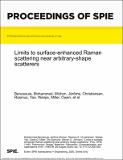Limits to surface-enhanced Raman scattering near arbitrary-shape scatterers
Author(s)
Benzaouia, Mohammed; Michon, Jérôme; Christiansen, Rasmus E.; Yao, Wenjie; Miller, Owen D.; Sigmund, Ole; Johnson, Steven G; ... Show more Show less
DownloadPublished version (1.460Mb)
Publisher Policy
Publisher Policy
Article is made available in accordance with the publisher's policy and may be subject to US copyright law. Please refer to the publisher's site for terms of use.
Terms of use
Metadata
Show full item recordAbstract
© COPYRIGHT SPIE. Downloading of the abstract is permitted for personal use only. Various scatterers such as rough surfaces or nanostructures are typically used to enhance the low efficiency of Raman spectroscopy (surface-enhanced Raman scattering). In this work, we find fundamental upper bounds on the Raman enhancement for arbitrary-shaped scatterers, depending only on its material constants and the separation distance from the molecule. According to our metric, silver is optimal in visible wavelengths while aluminum is better in the near-UV region. Our general analytical bound scales as the volume of the scatterer and the inverse sixth power of the distance to the active molecule. For periodic scatterers, a second bound with surface-area scaling is presented. Simple geometries such as spheres and bowties are shown to fall short of the bounds. However, using topology optimization based inverse design, we obtain surprising structures maximizing the Raman enhancement. These optimization results shed light to what extent our bounds are achievable.
Date issued
2020-08Department
Massachusetts Institute of Technology. Department of MathematicsJournal
Proceedings of SPIE - The International Society for Optical Engineering
Publisher
SPIE
Citation
Benzaouia, Mohammed, Michon, Jérôme, Christiansen, Rasmus E., Yao, Wenjie, Miller, Owen D. et al. 2020. "Limits to surface-enhanced Raman scattering near arbitrary-shape scatterers." Proceedings of SPIE - The International Society for Optical Engineering, 11462.
Version: Final published version